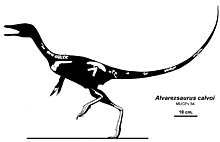Alvarezsaurus
| Alvarezsaurus Temporal range: Late Cretaceous,
| |
|---|---|

| |
| Skeleton restoration | |
| Scientific classification | |
| Domain: | Eukaryota |
| Kingdom: | Animalia |
| Phylum: | Chordata |
| Clade: | Dinosauria |
| Clade: | Saurischia |
| Clade: | Theropoda |
| Family: | †Alvarezsauridae |
| Genus: | †Alvarezsaurus Bonaparte, 1991 |
| Species: | †A. calvoi
|
| Binomial name | |
| †Alvarezsaurus calvoi Bonaparte, 1991
| |
| Synonyms | |
| |
Alvarezsaurus (/ˌælvərɛzˈsɔːrəs/; "Alvarez's lizard") is a genus of alvarezsaurid dinosaur from the Late Cretaceous, living in Argentina approximately 86 - 83 million years ago. It was a small dinosaur, measuring 1–1.4 m (3.3–4.6 ft) long and weighing approximately 3 kg (6.6 lb).[1][2] It was found in the Bajo de la Carpa Formation and was named by paleontologist José Bonaparte in 1991 after the historian Don Gregorio Alvarez.[3] The type species is A. calvoi.
Description
[edit]
Growing to measure 1–1.4 m (3.3–4.6 ft) and weigh around 3 kg (6.6 lb), Alvarezsaurus was a bipedal theropod. Like other lightweight theropods, it had a long tail, and its leg structure suggests that it was a fast runner. The most proximal elements of Alvarezsaurus caudal vertebrae exhibited ventrally sharp centra and the transverse processes of these vertebrae were sub-triangular and laterodistally directed, features seen in other alvarezsaurids like Shuvuuia.[4] Spinal processes were entirely absent or poorly developed, and each caudal vertebra supported short prezygapophyses. The scapula was visibly curved and proportionally smaller than those of other alvarezsaurids, and unlike its relatives Alvarezsaurus did not have a fused astragalus and calcaneum. It was unique in that its metatarsal III was its longest, followed by an unusually long metatarsal IV. It may have been insectivorous.[citation needed]
Classification
[edit]
Alvarezsaurus is considered basal to better-known members of its family, such as Mononykus and Shuvuuia. It has been alternately classified with both non-avian theropod dinosaurs and early birds, but a move of the alvarezsaurids to be recognized as more closely related to neornithine birds proved controversial despite being supported by earlier studies.[4] It was once believed that the Patagonian alvarezsaur taxa were the most basal of their family, but the discovery of a more basal member, Haplocheirus, disproved that when its fossils were discovered in China.[5]
References
[edit]- ^ Holtz Jr., Thomas R. (2012). "Holtz's Genus List" (PDF).
- ^ Paul, Gregory S. (2010). The Princeton Field Guide to Dinosaurs (1st ed.). Princeton University Press. pp. 126. ISBN 978-0691137209. JSTOR j.ctt7sv5n.
- ^ Bonaparte, José F. (1991). "Los vertebrados fósiles de la formación Río Colorado, de la ciudad de Neuquén y cercanías, Cretácico Superior, Argentina" [The fossil vertebrates of the Colorado River formation, from the city of Neuquén and surroundings, Upper Cretaceous, Argentina]. Revista del Museo Argentino de Ciencias Naturales "Bernardino Rivadavia". Paleontología (in Spanish). 4 (3): 15–123. ISSN 0524-9511.
- ^ a b Chiappe, Luis M.; Norell, Mark A.; Clark, James M. (5 December 2002). "The Cretaceous, Short-Armed Alvarezsauridae: Mononykus and Its Kin". In Chiappe, Luis M.; Witmer, Lawrence M. (eds.). Mesozoic Birds: Above the Heads of Dinosaurs. University of California Press (published December 2002). pp. 87–120. ISBN 978-0520200944.
- ^ Choiniere, Jonah N.; Xu, Xing; Clark, James M.; Forster, Catherine A.; Guo, Yu; Han, Fenglu (29 January 2010). "A Basal Alvarezsauroid Theropod from the Early Late Jurassic of Xinjiang, China". Science. 327 (5965): 571–574. Bibcode:2010Sci...327..571C. doi:10.1126/science.1182143. PMID 20110503. S2CID 36904501.










